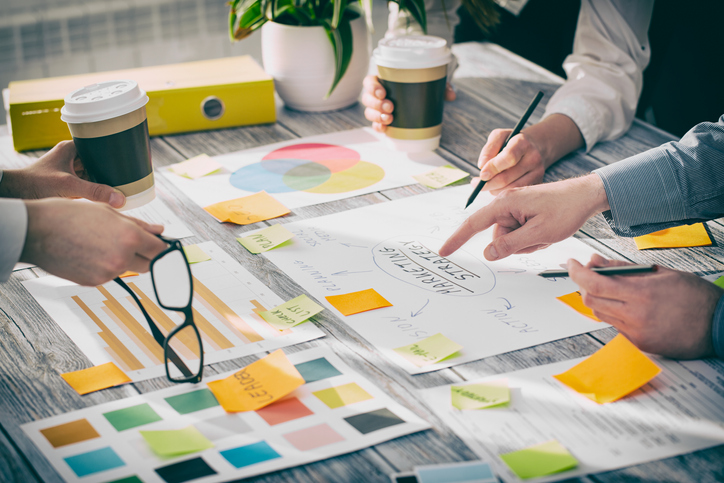Producing a top-notch magazine requires blood, sweat, and tears. Well, maybe not exactly—but it can feel that way with the amount of work that goes into making one. Magazines are filled with large amounts of content, pictures, infographics, and more, all of which need to follow a similar style and layout while remaining unique and intriguing on every page. Simply put, making a compelling magazine is no easy feat.
When you’re creating a magazine, your first step should be to have the right strategy and team behind you to support your creative efforts. But there’s so much more that goes into the process. We’ve put together a few of our favorite tips to help you build a more creative, eye-catching magazine that engages your readers and draws in prospective readers. These include choosing the right typeface, wrapping text uniquely, layering your text and images, and building a better contents page.
Keep Your Typeface Simple but Unique
You’ll be amazed by how many typeface options exist—if you can dream it, someone else has already made it. But obviously, not every typeface is suitable for your project.
Above all, keep your style and voice in mind when searching for the right typeface to make sure you select something that conveys them well. In addition, make sure your choice of font is suitable for your target audience. Are your readers looking for something playful or serious?
Bold options are popular and can really make a statement next to your photography and other content. Boxier fonts can come off more serious, while rounded ones are usually seen as more fun and relaxed. Take some time to lay out a few of your main titles in different typefaces and review them all with your team to get as many opinions as possible on what suits your magazine best.
The right typeface can make a huge difference in how readers see your magazine as a whole. They’re usually pretty inexpensive to buy, and you can use the typeface throughout your entire magazine. Want a unique typeface that you’ve never seen before? That’s an even bigger bonus! Let your voice be heard and your photos complemented through the text on your pages.
Wrap Your Text with Purpose
Not every page in your magazine is going to have the space to support classic column text. This content layout may work in lots of areas, but certain pictures may force you to get more creative with your text placement. You may have seen other magazines put text in circular shapes or similar layouts, but your creativity doesn’t have to stop there.
Choose a picture with a lot of white space to give you room, and wrap the text around the image as tightly as possible. Your text can bend and shape throughout the page, giving it a more unique look and helping you fit in all the text you need without having to shrink images or remove content.
Work in Layers
With flat pages, you need to get creative and make your text and images pop off the page. Working in layers is one of the better ways to achieve this, and it’s simpler than you think. Your designers can build pages so that portions of your text rests behind your images while others go in front.
Alternating the layering of your text and images is a great way to make your page more eye catching for your readers, encouraging them to browse more of the content. With the right design, you can create a 3D look for your images and text, even on a classic 2D page!
Transform Your Contents Page
The cover of your magazine is your first impression—and sometimes your only shot at getting someone to pick it up off the shelf. But once you’ve accomplished that, where else in your magazine do you draw them in?
Your contents page shows your readers what they’re getting into; if it’s dull, dry, or simply hard to read, they may toss the magazine aside just as quick as they picked it up. Your contents page doesn’t have to be limited to just one or two pages; you should extend it as far as it needs to go to include exciting images and layouts that will engage your readers and entice them to read on.
Remember: If you want to engage your readers and get them to read beyond the cover, you need to leave a stellar first impression of your magazine’s contents. Your investments here will pay off.
Final Thoughts
After the long and tiring process of building your magazine—from design to content planning and development—are you making sure the print process is also up to par? You can’t cut corners on how you print your magazine, especially after all the time and effort that was put into its initial creation.
At Seaway Printing, we understand the needs of magazine publishers. We work exclusively with companies just like yours to make sure your content jumps out of the page, as it should.Contact us today to learn more about our services and how Seaway can impress your readership with our world-class manufacturing and print process.
Recent Posts
Archives
- October 2023 (1)
- August 2023 (2)
- July 2023 (2)
- June 2023 (3)
- April 2023 (1)
- February 2023 (3)
- January 2023 (1)
- April 2022 (1)
- February 2022 (3)
- September 2021 (1)
- June 2021 (4)
- March 2021 (3)
- February 2021 (1)
- August 2020 (1)
- July 2020 (2)
- June 2020 (1)
- May 2020 (3)
- April 2020 (2)
- January 2020 (2)
- December 2019 (1)
- November 2019 (2)
- October 2019 (1)
- September 2019 (1)
- April 2019 (1)
Categories
Connect With Us
Seaway
1609 Western Avenue
Green Bay, WI 54303
info@seawayprinting.com
Toll Free: 800.622.3255
Fax: 920.468.0443
Local: 920.468.1500

